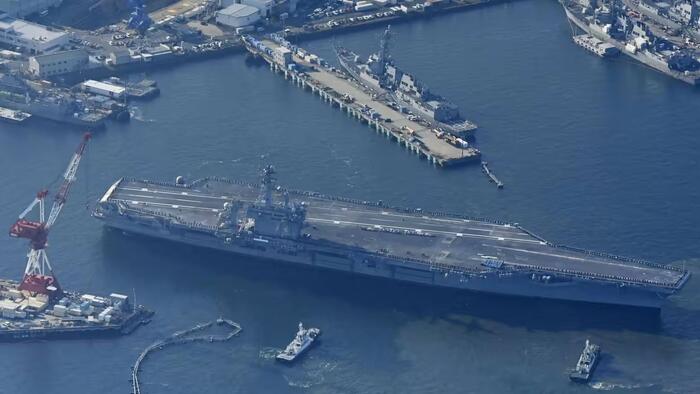In a significant military development, three US aircraft carriers are set to converge in Asia by next week, marking a notable return to the region after months of absence due to heightened tensions with China. The USS George Washington, with a crew of 2,702, docked in Yokosuka, Japan, on November 22, 2022, for the first time in over nine years. This deployment comes after the USS Carl Vinson was dispatched to the Pacific, and the USS Abraham Lincoln is currently in the Indian Ocean, passing through the South China Sea on its way back to San Diego. The increased presence of these naval forces is seen as a strategic move to bolster rapid response capabilities and reassure allies amid ongoing concerns regarding Chinese military activities, particularly in the South China Sea and around Taiwan.
This return of the aircraft carriers is timely, coming after the US has been devoid of a forward-deployed carrier in Asia since mid-May, when the USS Ronald Reagan left Yokosuka. The absence was primarily due to the diversion of naval resources to the Middle East as tensions escalated in the region following Israel’s military actions in Lebanon and ongoing Iranian threats. The recent deployment of the USS George Washington, alongside the USS Carl Vinson and the USS Abraham Lincoln’s route through contested waters, underscores the US’s commitment to maintaining security and stability in the Asia-Pacific region in the critical lead-up period to President-elect Donald Trump’s inauguration.
Analysts suggest that the increased US military presence aims to deter potential aggressive actions by China, which is perceived as the primary threat in the region. As the Trump administration prepares to take office, there is concern that China may test US resolve, particularly concerning Taiwan and the South China Sea. Brent Sadler, a senior research fellow and Navy veteran, emphasizes that China is likely probing the new administration’s policies, which could swing between a more transactional and a confrontational approach. Thus, establishing a robust military posture in the Pacific is crucial to convey a message of deterrence, particularly in light of Chinese provocations that have surged during the period of limited US naval presence.
The US Navy’s deployment challenges are compounded by the simultaneous military commitments in other regions, like Ukraine and Gaza. Many of the country’s 11 aircraft carriers are either under maintenance or have recently returned from extensive deployments. The Pentagon, led by Secretary of Defense Lloyd Austin, has prioritized its resources toward these conflicts, inadvertently allowing a vacuum in the Pacific that has emboldened China to engage in more pronounced military posturing. Analysts suggest that this absence of US naval power has led to increased provocations from China, indicating a need for a strategic reset within US operations in the Indo-Pacific.
In response to this gap, the US initially deployed the USS Theodore Roosevelt to the region, only to redirect it to address emergencies in the Middle East. A similar fate befell the USS Abraham Lincoln, which also had its original deployment redirected shortly after it was sent to Asia. Such fluctuations in naval assignments reflect the broader strategic challenges facing US military planners as they navigate the competing needs of multiple global hotspots. Ensuring a powerful maritime presence in the Pacific is critical, not only for direct defense actions but also for signaling US commitment to allies and partners in the region.
As the Trump administration approaches its inauguration, it becomes vital for the United States to reassess its military strategies and ensure that the necessary assets are in place to counter any aggressive moves from China. The return of these aircraft carriers emphasizes a significant shift in focus back to the Pacific, where tensions with China remain a pressing issue. By consolidating naval power in the region, the US aims to demonstrate its resolve and commitment to security in the Asia-Pacific, reassuring both allies and adversaries alike of its strategic intent. Critics and supporters of the military strategy alike recognize that the upcoming weeks will be pivotal for determining the tone and nature of US-China relations moving forward.

